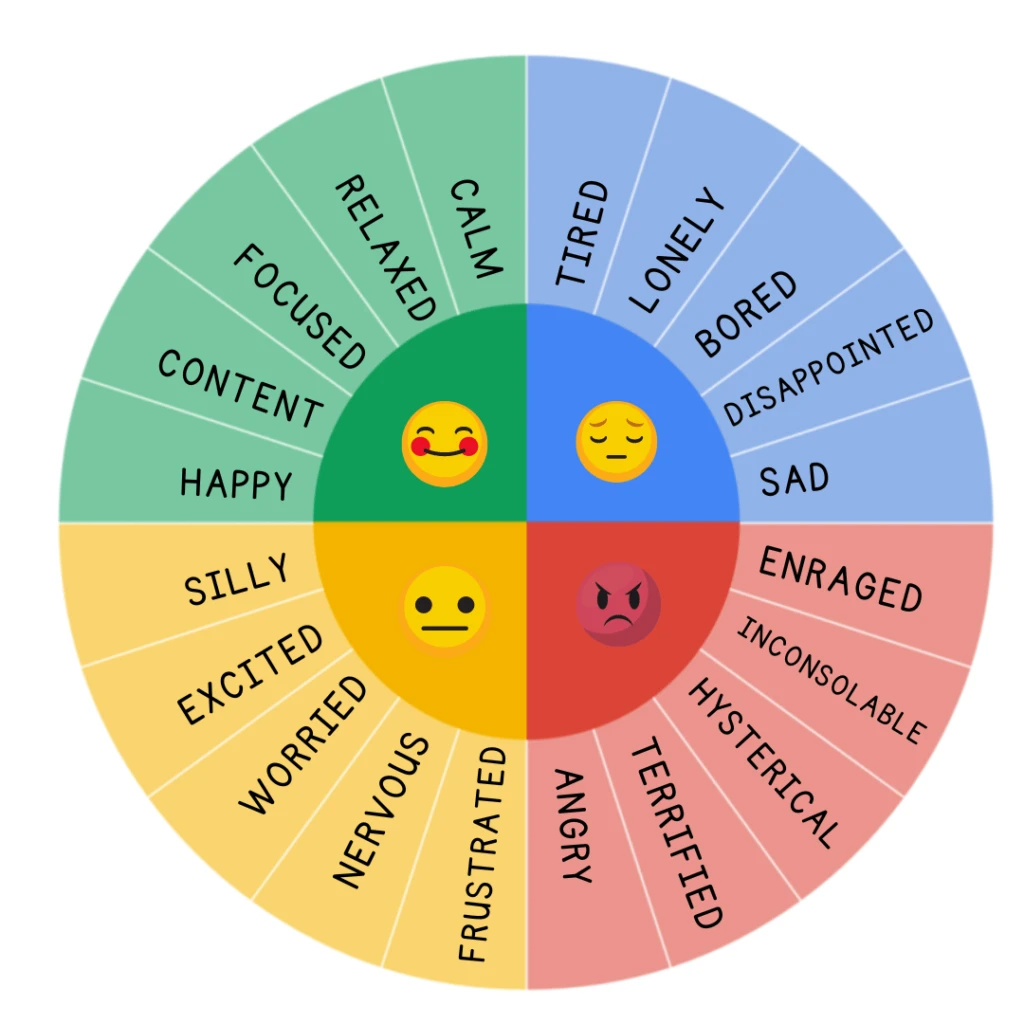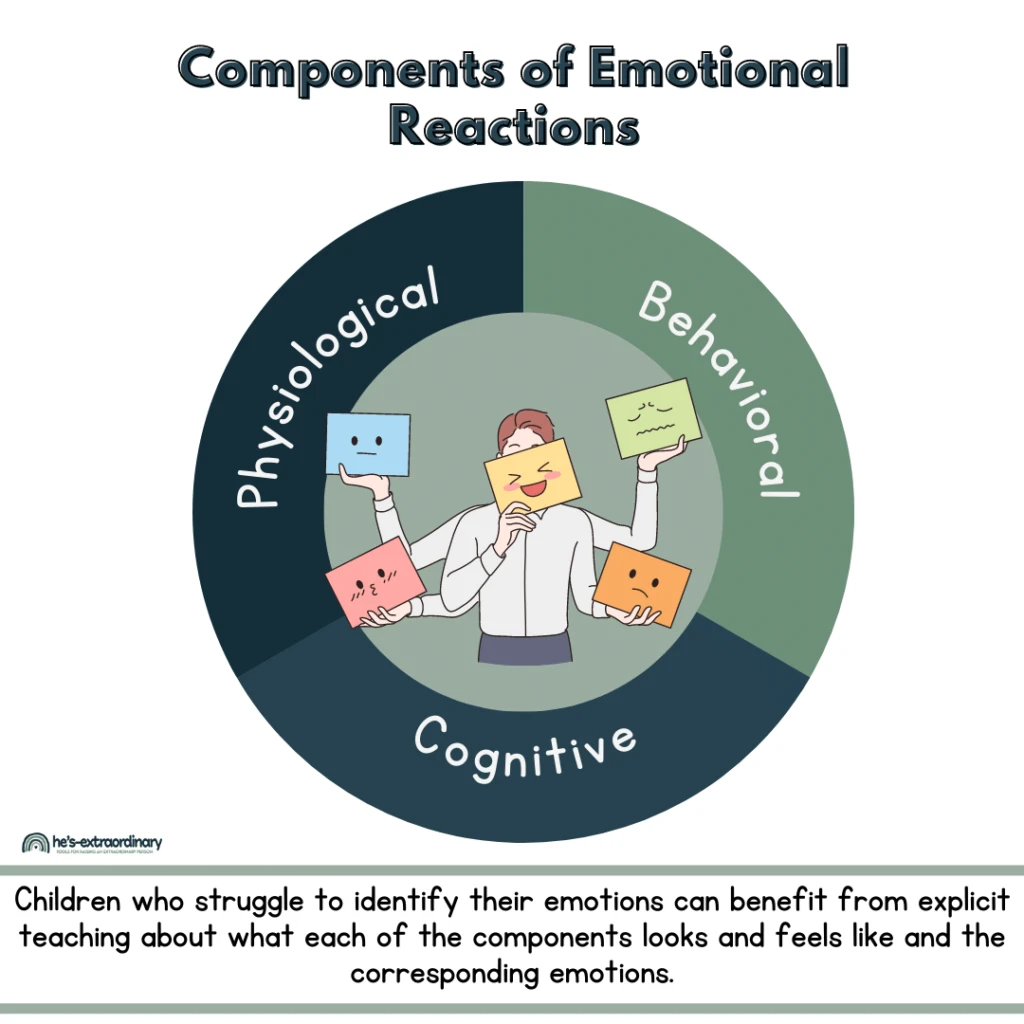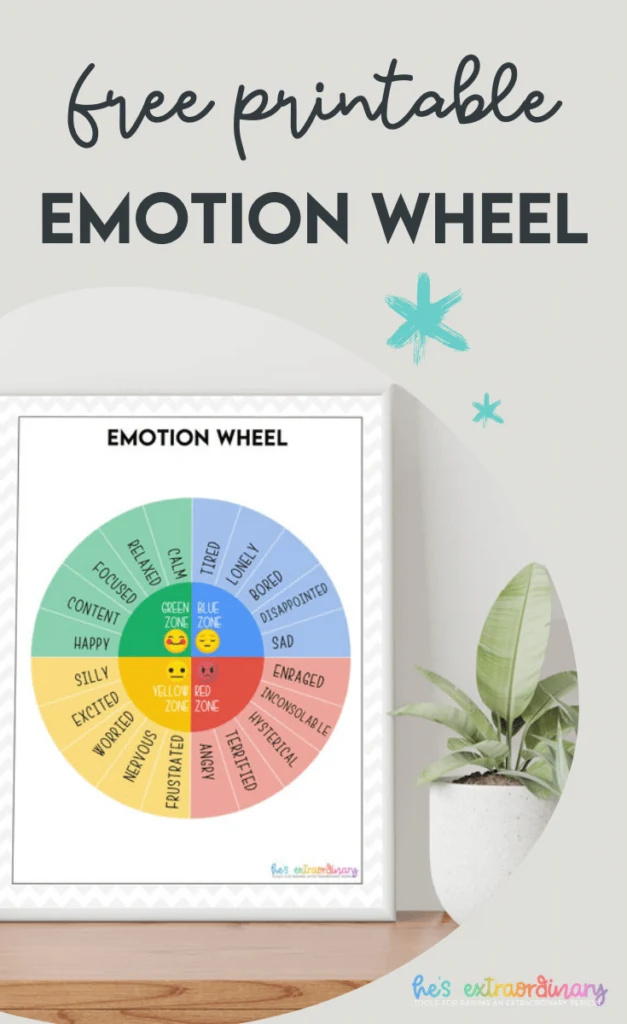What’s inside this article: A modified version of Plutchik’s Emotion Wheel that’s suitable for use with children. Includes a few ideas for using the feelings wheel printable, along with some other resources for teaching children about emotions.

Use this simple feelings wheel printable to help your kids learn to identify their feelings.
This idea is inspired by Plutchik’s Emotion Wheel, which I then simplified and color-coded the emotions based on the Zones of Regulation to make it kid-friendly and easy to follow.
Did you know that there are actually about 34,000 different human emotions? Yikes.
You can use this emotion wheel as a starting point with children to help expand their emotive vocabulary.
Being able to recognize emotions is important.
Kids who are able to identify what they’re feeling:
- Display fewer behavior problems
- Do better in school
- Are more empathetic and supportive of others
- Develop healthy coping skills and resilience
- Have a positive self-image
- Have positive and stable relationships with others
- Better mental health
Recognizing emotions comes naturally to a lot of children, but for some kids, it’s a big struggle. When that’s the case, they need to be taught how to identify their emotions.

Feelings Wheel Printable
This is an image of the feelings wheel. There is a link at the bottom of the post to download a high-quality PDF version that you can print and use as a visual for the classroom or calm down corner.

Components of Emotional Reactions
There are three components to every single emotion we experience.
Physiological:
What happens in your body?
What is your arousal level? In the Zones of Regulation, each zone actually represents a level of arousal. The emotions that fall into each zone have a similar effect on arousal.
Blue zone is low energy, green is ideal, yellow is slightly elevated and red is extremely high arousal.
There are more specific physiological responses to each emotion. For example, excited and worried both fall into the yellow zone. Both emotions cause an elevated arousal level. However, the two emotions feel very different.
Behavioral:
The behavioral response to the emotion.
As mentioned, you experience a similar arousal level when you’re both worried and excited. However, with worry, you may get fidgety and hypervigilant but with excitement, you may be giggly and talk a lot.
Cognitive
This is the conscious experience during the emotional experience. What are you thinking? This includes your thought patterns, how you label the emotion, the speed of your thoughts, etc.

Emotional Regulation
Emotional regulation means you can calm down and cope with your emotions in an appropriate way.
Things like walking away from a frustrating situation and returning to talk when you’re calm, doing deep breathing exercises, or watching a funny movie when you’re sad are all examples of emotional regulation strategies.
The emotion wheel will help you build on these concepts and develop emotional regulation.
Ways to Use The Feelings Wheel Printable
There are many different wants you can use the feelings wheel as a teaching tool for kids.
These are just a few ideas.
- Pair the emotion wheel with Zones of Regulation activities and printables – Find them here.
- Use it as a starting point and brainstorm other emotions with the child. How many emotions can they think of?
- Go over this list of emotions and decide which section on the emotion wheel they would fit into. Some of these are challenging, so kids won’t be able to complete on their own, work together, or in a group.
- Have your child/students write about a time that they felt a particular emotion on the emotion wheel.
- Laminate and hang this up in your calming corner.
- Talk about how fictional characters from books, TV, or movies are feeling using the emotion wheel as an aid.
- First, complete the “What Zone are THEY in?” activity. Then, for each zone, examine the pictures and guess which emotion from the feelings wheel printable they are experiencing.
Social-Emotional Learning Resources
There are lots of social-emotional learning resources available on the blog. Here are some you may like:
- Understanding & Coping with Emotions Printable Mega Bundle
- 5 Minute Bio-Feedback Activity for Self Regulation
- How Do I Feel? Emotions Activity Booklet
- Feelings Check-In & Emotion Chart
- Children’s Books about Emotions
- Therapy Games that Teach Emotional Regulation
- The Best Julia Cook Books for Social-Emotional Learning
- Kids Anger Management
Download the Feelings Wheel Printable
You can get the high-quality PDF version of this feelings wheel printable and use it at home or in the classroom.
Emotions Wheel
